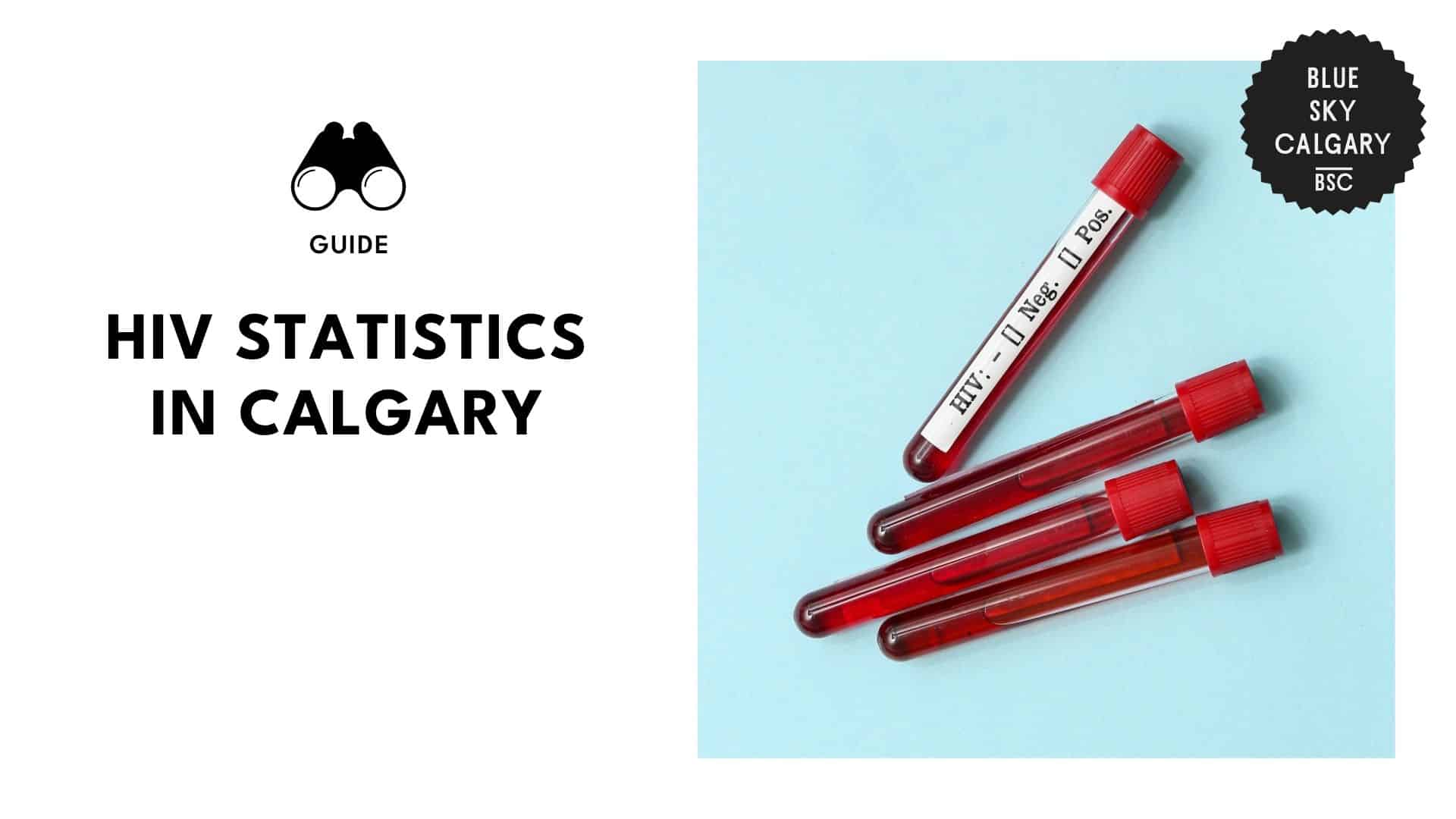Calgary’s Rising HIV Statistics: Figures, Trends, and Solutions
Key Insights
| Data from the Alberta Notifiable Diseases Report reveals that between 2019 and 2023, HIV cases in the city increased by 97.3%. A report by Statista shows that in 2022, Alberta reported a total of 4.2 first-time HIV diagnoses per 100,000 people, placing it in the midrange for the total number of transmissions when compared to other provinces. The 2022 Report on Sexually Transmitted Infections and HIV in Alberta found that a total of 8,222 cases were recorded in the city. This includes cases of HIV, chlamydia, infectious syphilis, and gonorrhea. The same report also illustrates how the majority of HIV transmissions in 2022 were found in males, who made up 62.2% of the total number of cases. According to the Health Network, the lifetime cost of treating one individual living with HIV is around $153,000, which accounts for HAART expenses, routine medical visits, and ongoing monitoring. |
According to the Alberta Notifiable Diseases Report, new cases of human immunodeficiency virus (HIV) in Alberta have risen sharply over the past five years, with the largest increases occurring in more recent years.
In 2019, Alberta reported 257 new HIV cases. This figure served as the report’s baseline before the COVID-19 pandemic and reflects the pre-pandemic landscape of HIV testing, treatment, and prevention in the province.
During the onset of the pandemic in 2020, the number of newly reported cases dropped to 195, which is a 24.1% decrease compared to 2019. However, it is likely that this decline does not indicate a reduction in actual transmission.
Rather, this could have been caused by pauses in testing services, reduced access to clinics, and delayed medical appointments during the height of the pandemic’s quarantine restrictions.
By 2021, cases rose again to 247, which is a 26.7% increase from the previous year. This rise suggests that testing resumed and more individuals were diagnosed as healthcare services stabilized.
In 2022, the number of new cases climbed further to 293. This represented an 18.6% rise from the previous year.
The continued rise in transmissions may have been influenced by factors such as behaviors during sexual intercourse or delays in initiating preventive measures like pre-exposure prophylaxis (PrEP).
However, the most significant change occurred in 2023, when reported HIV cases surged to 507. This was a 73.0% increase from the previous year and nearly double the number reported in 2019.
Compared to the number recorded in 2019, the 2023 total reflects a 97.3% increase in new cases in just five years.
This rising trend may reflect growing actual transmission rates or could be due to improvements in detection and reporting methods. Nevertheless, these rises highlight the need for increased public health attention in the city.
| Year | Number of HIV Cases | Percentage Change from Previous Year |
| 2019 | 257 | – |
| 2020 | 195 | -24.1% |
| 2021 | 247 | +26.7% |
| 2022 | 293 | +18.6% |
| 2023 | 507 | +73.0% |
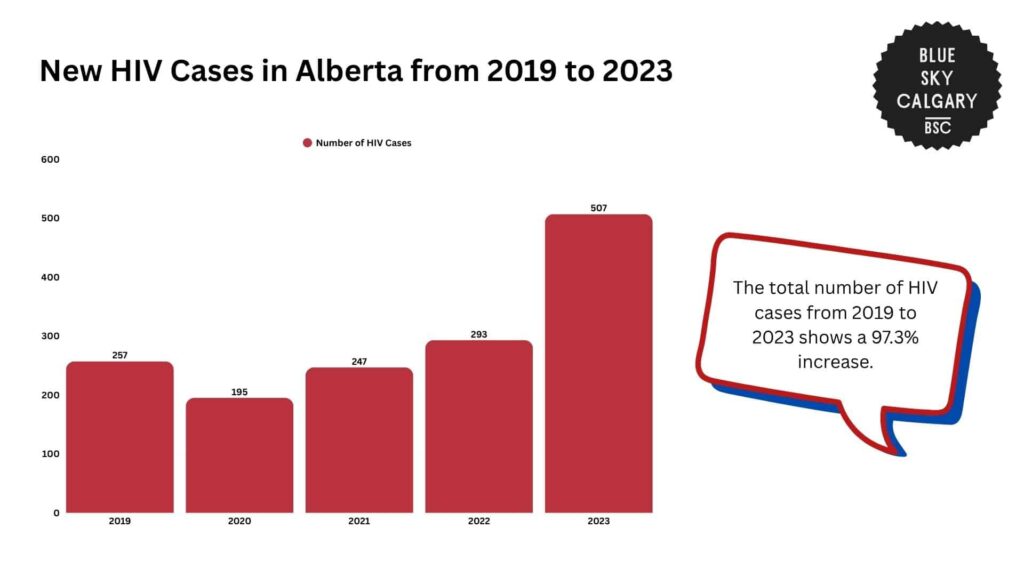
Regional Analysis of HIV Trends Across Regions in Canada
Statista gives insights into trends of HIV transmission across various regions in Canada.
In 2022, Alberta reported a first-time HIV diagnosis rate of 4.2 cases per 100,000 population. This places the region in the midrange when compared to others in the country.
Saskatchewan reported the highest first-time HIV diagnosis rate in the country, at 19 cases per 100,000 population. This is 352% higher than Alberta’s rate.
This difference is quite significant and suggests that Saskatchewan may be experiencing more intense outbreaks or long-standing health issues that have not been properly addressed.
Manitoba follows with the second-highest HIV diagnosis rate at 13.9 per 100,000 population. This is equivalent to a 231% higher rate than that of Alberta’s.
The figure suggests that Manitoba, like Saskatchewan, may also be facing specific healthcare challenges, like a lack of preventive medication or sex education services.
Quebec reported a diagnosis rate of 4.9 per 100,000, which is only slightly above Alberta’s rate by 0.7 cases, or a 16.7% difference.
Both provinces have large urban centers and diverse populations, and their similar rates may reflect shared risk patterns and trends in healthcare services.
Meanwhile, Ontario recorded a rate of 4.1 per 100,000. This is slightly below Alberta’s rate by 0.1, or 2.4% lower.
These almost equivalent rates suggest that Alberta and Ontario also face similar public health contexts and problems when it comes to HIV transmission.
British Columbia had a noticeably lower rate at only 2.5 per 100,000 population. This is 40.5% lower than Alberta’s rate.
The lower figure suggests that the province has a better emphasis on HIV prevention and reduction strategies or stronger efforts for sex education.
Furthermore, the Atlantic provinces collectively reported a rate of 1.6 per 100,000, which is 61.9% lower than the rate in Alberta.
The territories followed with the lowest reported rate in the country at only 1.5 per 100,000, or 64.3% lower than Alberta.
These low figures may be due in part to smaller population sizes, fewer large urban centers, or more effective local health strategies.
However, they could also reflect underreporting in areas with limited healthcare access or inconsistent testing coverage.
Overall, Alberta is in a middle position when it comes to HIV transmissions in the country.
While it does not face the same level of urgency as provinces like Saskatchewan and Manitoba, its rate is still higher when compared to several other provinces.
| Region | Rate | Comparison to Alberta |
| Saskatchewan | 19.0 | 352% higher |
| Manitoba | 13.9 | 231% higher |
| Quebec | 4.9 | 16.7% higher |
| Alberta | 4.2 | – |
| Ontario | 4.1 | 2.4% lower |
| British Columbia | 2.5 | 40.5% lower |
| Atlantic Provinces | 1.6 | 61.9% lower |
| Territories | 1.5 | 64.3% lower |
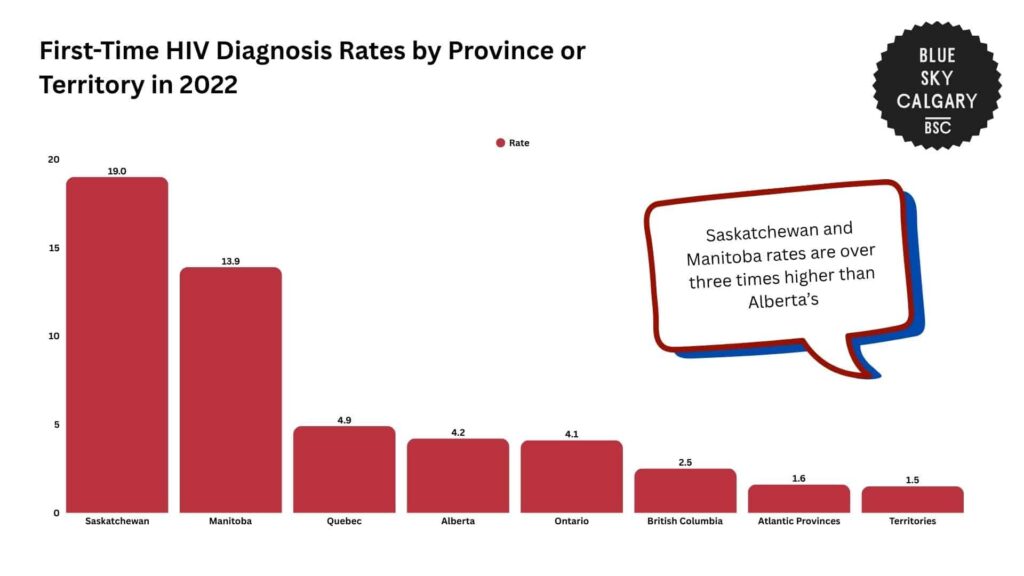
Trends in Sexually Transmitted Infections in Calgary
The 2022 report on sexually transmitted infections and HIV in Alberta gives insights into the specific cases of HIV and other sexually transmitted infections across the city.
A total of 8,222 cases were recorded, which include reports of chlamydia, gonorrhea, infectious syphilis, and HIV.
There was a consistent increase across all four infection types, which could be affected by sexual transmission patterns, testing accessibility, and behavioral risk factors of people in the city.
Calgary reported 111 newly diagnosed HIV cases in 2022, which is a 20.7% increase compared to the 92 cases recorded in 2021.
This means that a total of 19 individuals contracted HIV within a year. Although another possible factor is the resumption of healthcare services after pandemic-related quarantine policies, which may have led to more people getting tested and diagnosed.
When adjusted for population, Calgary recorded an HIV rate of 6.2 cases per 100,000 individuals. This was a 16.9% increase from the previous year’s rate.
Chlamydia was the most frequently reported sexually transmitted infection (STI) in Calgary, with 5,880 confirmed cases in 2022. This is a substantial 24.8% increase from the 4,712 cases recorded in 2021, with 1,168 additional cases reported.
The rate for chlamydia cases also reached 329.7 cases per 100,000 population, which is also a 20.9% increase from the previous year.
This rise could have been caused by the fact that chlamydia often presents no immediate symptoms. This also highlights the issue of asymptomatic transmission, which would mean that actual rates in the city could be higher.
Cases of gonorrhea saw a notable increase, although smaller in scale. Calgary recorded 1,449 gonorrhea cases in 2022, which is 98 more than the 1,351 cases reported in 2021 and a 7.3% increase in total cases.
The infection rate for gonorrhea also rose to 81.2 cases per 100,000 population, representing a 3.9% increase from the year before.
While this rate is lower than the rise in chlamydia, the continued growth in gonorrhea cases signals potential issues in condom use consistency, antibiotic resistance, and access to timely treatment.
Moreover, infectious syphilis cases totaled 782 in 2022, up from 694 in 2021. This was an increase of 88 cases, which is equivalent to a 12.7% rise.
The rate of infectious syphilis reached 43.9 per 100,000 population, which reflects a 9.2% increase from the previous year.
Rises in cases of syphilis are particularly concerning due to its ability to cause serious complications if left untreated.
Altogether, these figures show a concerning trend of increasing cases of HIV and other major types of STIs across the city.
| Condition | Total Cases | Increase from 2021 | Rate per 100,000 Population | Increase from 2021 |
| Chlamydia | 5,880 | +24.8% | 329.7 | +20.9% |
| Gonorrhea | 1,449 | +7.3% | 81.2 | +3.9% |
| HIV | 111 | +20.7% | 6.2 | +16.9% |
| Infectious Syphilis | 782 | +12.7% | 43.9 | +9.2% |
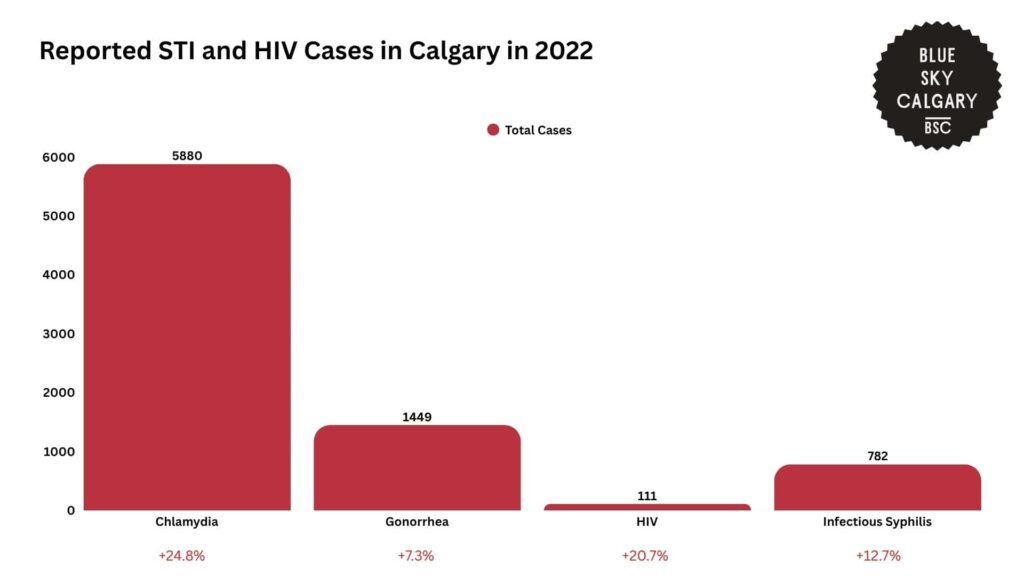
Demographic Trends in HIV and STIs
Trends by Gender
A 2022 report by the Government of Alberta on sexually transmitted infections and HIV reveals trends in how these issues affect different demographics.
The gender distribution of reported STI and HIV cases in Calgary shows different patterns of transmission across infection types.
For HIV, the majority of cases reported in 2022 came from males, at 62.2%. This means that only 37.8% came from females.
This gender distribution shows that men are at a higher risk of contracting HIV, possibly due to the nature of sexual contact among men.
Although females represent a smaller proportion of HIV diagnoses, their risk remains significant and may be influenced by factors such as lower perception of risk, limited access to preventive medication, or delayed testing.
Conversely, trends for chlamydia cases showed a different pattern. In 2022, 54.7% of chlamydia cases in Calgary were among females, while 45.3% were among males.
Chlamydia often presents without symptoms, especially in women, which may lead to late diagnosis if routine screening is not conducted. This then heightens the chances of passing on the infection.
On the other hand, gonorrhea cases were more common among men, with 67.2% of reported cases occurring in males, and only 32.8% in females.
Similarly, cases of infectious syphilis also showed a disproportionate rate for males. A total of 62.8% of reported cases were in men, and only 37.2% came from women.
Thus, the data shows that men have higher risks of transmission for both HIV and most major STIs. This may be attributed to male sexual behavior, limited education on prevention, or lack of access to preventive services.
Moreover, certain subgroups within the male population may be more vulnerable to transmission, like those involved in unsafe sex work.
| Condition | Percentage of Females | Percentage of Males |
| Chlamydia | 54.7% | 45.3% |
| Gonorrhea | 32.8% | 67.2% |
| HIV | 37.8% | 62.2% |
| Infectious Syphilis | 37.2% | 62.8% |

Trends by Age Group
The age breakdown of STI and HIV cases in Calgary also shows which age groups of the population are most affected.
Among those diagnosed with HIV in Calgary in 2022, 47.2% were between the ages of 25 and 39. This age group accounts for nearly half of all HIV cases, which shows that young and middle-aged adults are a more vulnerable demographic.
This period in life often coincides with peak sexual activity and mobility, which may contribute to higher exposure to HIV risk factors.
For chlamydia, the most affected age group was 15 to 24-year-olds, making up 59.7% of all cases. This is also a younger demographic that represents a period of high sexual activity.
This highlights the importance of early and routine screening among adolescents and young adults, especially as chlamydia often presents no symptoms and can lead to complications if left untreated.
As for gonorrhea cases, these were concentrated among an older group, with those aged 30 to 39 years. This age group made up 36.9% of all reported cases.
This suggests that gonorrhea transmission remains high well beyond adolescence and into adulthood, particularly in sexually active populations who may not access regular STI testing.
Cases of infectious syphilis closely follow this pattern, as 35.8% of the total number of cases were reported in the 30 to 39 age group.
This similar age distribution with gonorrhea suggests that many of the same risk patterns may apply.
These could include one’s number of sexual partners, condom use consistency, or connection to certain demographics that are at higher risk of transmission.
In summary, the data reveal that while adolescents and young adults are heavily affected by HIV and some STIs, adults in their late twenties and thirties continue to carry a high burden, particularly for HIV, gonorrhea, and syphilis.
| Condition | Most Affected Age Group | % of Cases in Age Group |
| Chlamydia | 15–24 years | 59.7% |
| Gonorrhea | 30–39 years | 36.9% |
| HIV | 25–39 years | 47.2% |
| Infectious Syphilis | 30–39 years | 35.8% |
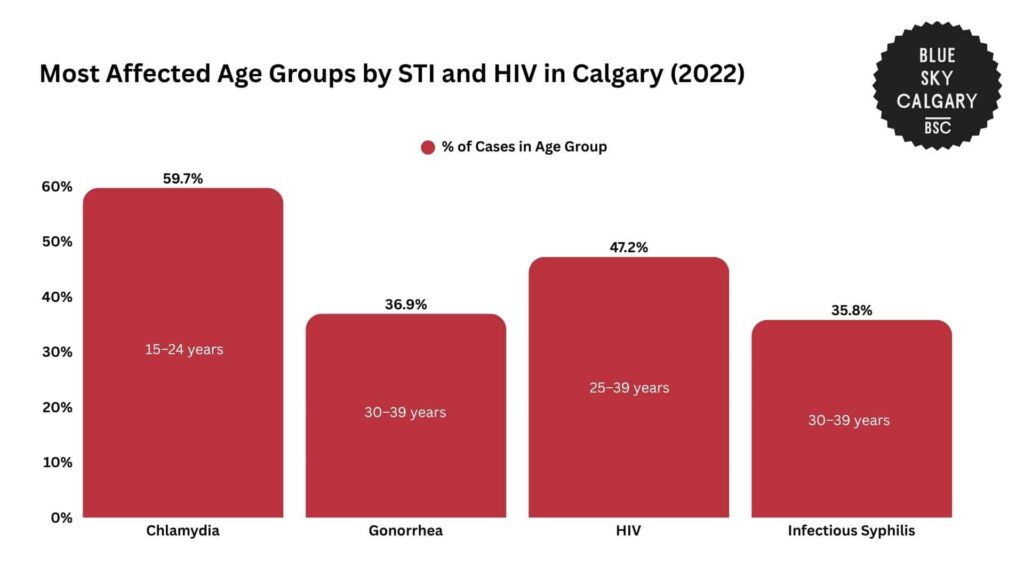
Costs and Consequences of Rising HIV Cases in Canada
According to the Health Network, the economic and social consequences of the HIV epidemic in Canada have been significant.
Beyond the direct medical impact on individuals, rising cases of HIV also create long-term financial burdens for both those affected and the broader society as a whole.
Thus, as cases of HIV and STIs continue to affect various groups, long-term investments in prevention, care, and support remain essential to reduce both human and economic losses.
The total cost of the HIV/AIDS epidemic in Canada is estimated at $36.3 billion. This includes both direct and indirect expenses.
Direct costs refer to healthcare-related expenditures such as medications, hospital care, physician services, and diagnostic testing.
These costs total $6.4 billion, including $5.4 billion for treating individuals living with HIV and $970 million attributed to AIDS-related deaths.
Indirect costs are significantly higher, totaling $29.9 billion. These include lost productivity, long-term disability, and premature death.
From this amount, $23.3 billion is linked to people currently living with HIV, while $6.6 billion stems from the economic impact of 11,000 AIDS-related deaths in Canada to date.
These figures show that indirect consequences, such as lost labor income and reduced quality of life, far exceed immediate treatment expenses.
The lifetime cost of treating one individual living with HIV is estimated at $153,000. This figure accounts for a combination of pre-HAART and HAART expenses (Highly Active Antiretroviral Therapy), routine medical visits, and ongoing monitoring.
When applied to thousands of individuals nationwide, the overall financial burden for treating these individuals becomes even larger.
Canada previously invested $83 million from public and private sources in 1996 to prevent the spread of HIV. This investment targeted education campaigns, harm reduction programs, testing, and early treatment.
Through modeling, the data also shows the potential value of investments in prevention. By reducing new infections to 1,700 per year by 2001, Canada was projected to save as much as $4 billion.
Lastly, the research also found that the burden of rising HIV cases has increasingly shifted toward marginalized populations, who lack access to basic healthcare and preventive services.
These include injection drug users, young gay men, Indigenous communities, and vulnerable women.
Without addressing the structural inequalities faced by these groups, the long-term social and financial costs of the epidemic are likely to persist and disproportionately affect these vulnerable communities.
| Cost Type | Amount | Description |
| Direct costs of HIV and AIDS | $6.4 billion | Medications, hospital care, physician services, and diagnostic testing |
| Indirect costs of HIV and AIDS | $29.9 billion | Lost productivity, long-term disability, and premature death |
| Lifetime cost of treating one individual living with HIV | $153,000 | HAART expenses, routine medical visits, and ongoing monitoring |
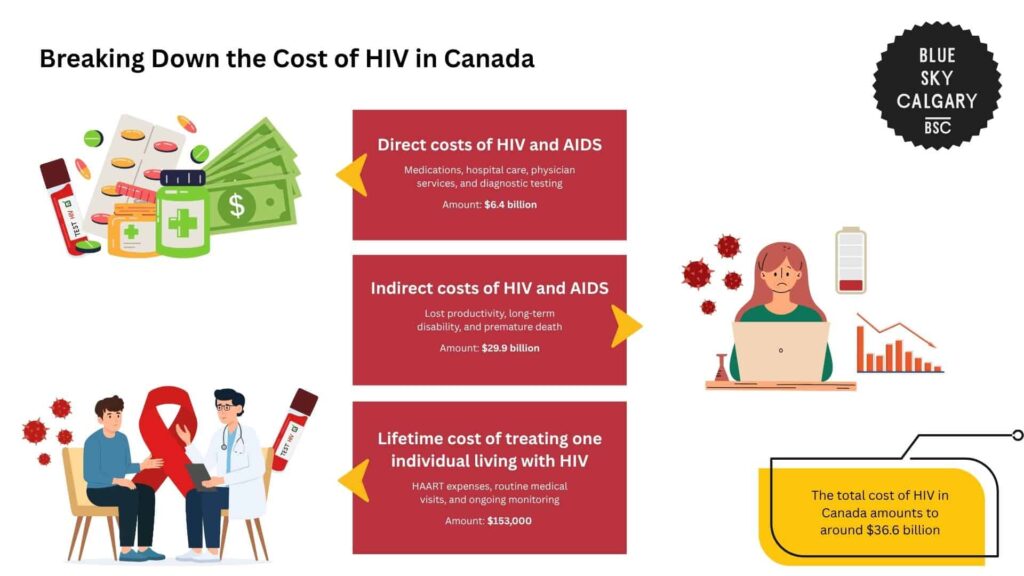
Interventions and Solutions to Rising HIV Cases in Calgary
The Alberta Community Council on HIV (ACCH) plays a central role in shaping the province’s response to HIV and related health issues.
As a provincial leader in community-based HIV work, ACCH supports collective action, coordination, and policy engagement to strengthen Alberta’s overall response to the epidemic.
Since the spread of HIV happens across all the cities in the region, one of ACCH’s primary functions is to lead province-wide initiatives that benefit from a unified and collective voice.
A major focus of the work done by ACCH includes contributing to policy discussions, initiating research efforts, and identifying gaps in service delivery that affect people living with or at risk of HIV.
ACCH also focuses on removing systemic barriers by developing targeted initiatives to overcome them. Examples of this may include advocacy campaigns or direct engagement with decision-makers.
Furthermore, the organization collaborates closely with provincial and federal leaders to influence resource allocation and increase awareness of HIV-related issues.
Input gained from these partnerships aims to ensure that public policies better reflect the needs of communities affected by HIV.
Another key area of ACCH’s work is supporting greater involvement of individuals with lived experiences. Through this, the organization finds opportunities for people living with HIV and those at risk to participate meaningfully in decisions that affect their health.
In doing so, their approach helps to ensure that public health responses are shaped by those most directly impacted by them.
Furthermore, the organization identifies provincial and federal-level opportunities to promote harm reduction through education, prevention, stigma reduction, access to safe drug consumption services, and improved healthcare access.
All of these activities help to support both prevention and care initiatives by addressing broader social determinants of health.
Meanwhile, the Government of Alberta also delivers HIV prevention education through its public health platform by promoting the use of pre-exposure prophylaxis, or PrEP.
Several accessible online resources help to explain how PrEP works, who is eligible, and how individuals can begin treatment through Alberta Health Services or their healthcare provider.
Here, PrEP is emphasized as a highly effective daily medication that reduces the risk of HIV infection by over 90% when taken consistently.
In addition to providing clinical guidance, these services help increase public awareness, reduce misinformation, and encourage at-risk individuals to seek preventive care early.
Through this approach, the province aims to normalize PrEP use as a standard component of HIV prevention and empower individuals to take proactive steps in managing their health.
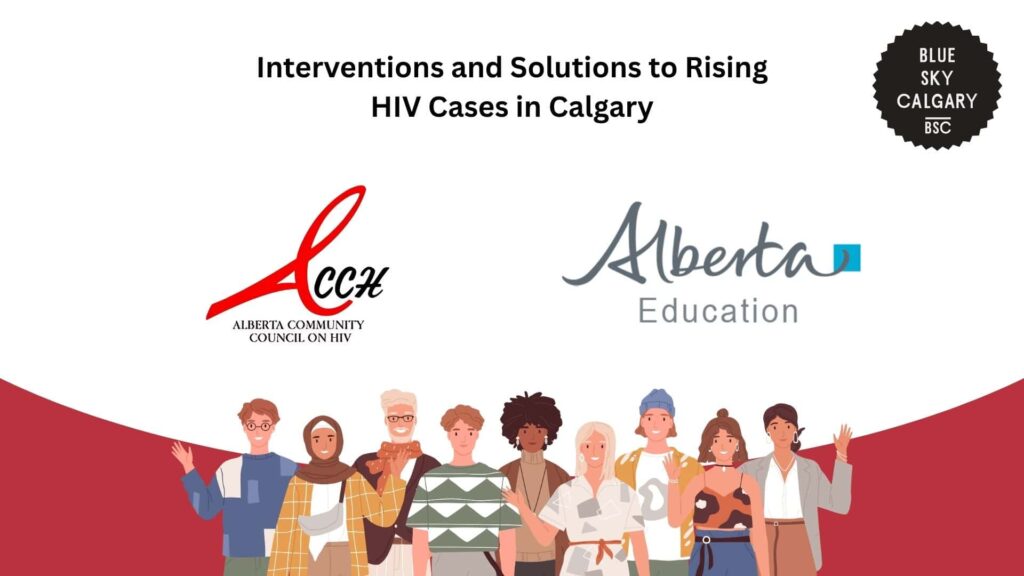
The Future of HIV and STI Trends in Calgary
Based on current trends, Calgary is likely to see continued increases in reported HIV and STI cases unless significant new interventions are introduced and existing programs are expanded.
Between 2021 and 2022, HIV cases in Calgary rose by 20.7%, reaching a total of 111. If this growth rate were to continue at a similar pace, the number of new HIV cases in Calgary could exceed 130 within the next two years.
These rises were also seen in other STI cases, such as chlamydia, infectious syphilis, and gonorrhea. Thus, the city could also see a persistent rise in these infections as well.
Moreover, these projections highlight the importance of maintaining a strong public health infrastructure and increasing access to HIV prevention tools such as PrEP.
Without further investment in prevention, testing, and education, Calgary may face a continued upward trend in HIV and STI cases, placing additional pressure on healthcare services and public health systems.
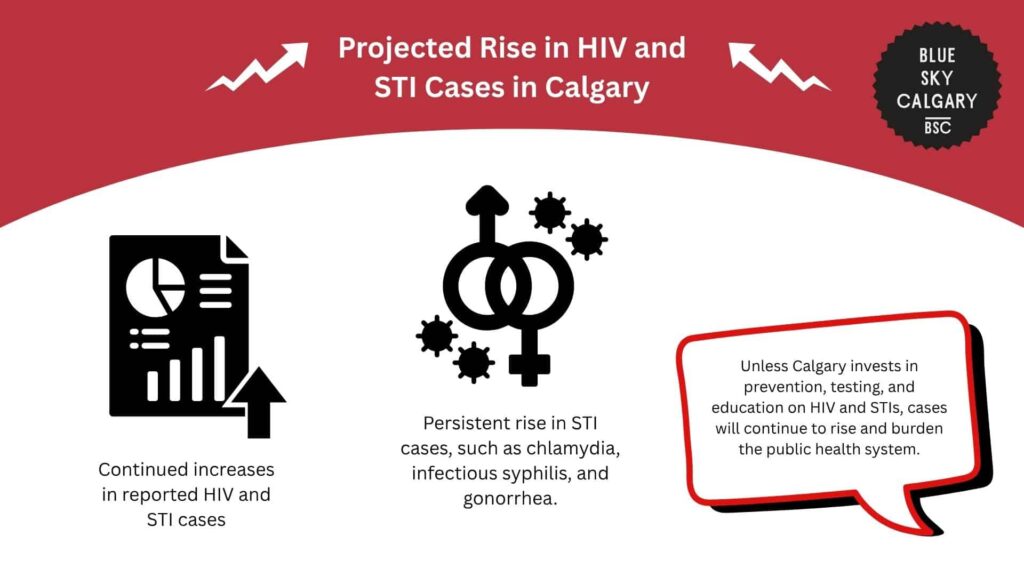
References
- Alberta Health. (2024). Alberta notifiable diseases summary 2023. Government of Alberta. https://open.alberta.ca/dataset/f35ea977-a82d-442b-b16f-99ed82560515/resource/8f04baf0-4f0b-4b88-a6d5-38047752b859/download/hlth-alberta-notifiable-diseases-summary-2023.pdf
- Brown, S. (2024, March 1). Alberta sees alarming rise in HIV cases, prompting calls for action. CBC News. https://www.cbc.ca/news/canada/calgary/alberta-hiv-cases-rising-1.7356410
- Statista Research Department. (2023, September 19). Rate of first-time HIV diagnoses in Canada in 2022, by province or territory. Statista. https://www.statista.com/statistics/1481126/rate-of-hiv-diagnoses-in-canada-by-province-or-territory/
- Alberta Health. (2023). Sexually transmitted infections and HIV: 2022 annual report. Government of Alberta. https://open.alberta.ca/dataset/c6850032-20d3-4845-a465-568ed7e61b7c/resource/facb3e6b-3890-4606-be07-45d5c35565e9/download/hlth-alberta-sexually-transmitted-infections-and-hiv-2022.pdf
- Canadian Policy Research Networks. (2002). The social and economic impacts of HIV/AIDS in Canada. https://oaresource.library.carleton.ca/cprn/18424_en.pdf
- Alberta Community Council on HIV. (n.d.). Home. https://www.acch.ca/
- Government of Alberta. (n.d.). Pre-exposure prophylaxis (PrEP). MyHealth Alberta. https://myhealth.alberta.ca/Alberta/Pages/PrEP.aspx
- CATIE. (2023, October 11). Calgary doctors find that more older people are getting HIV. https://www.catie.ca/catie-news/calgary-doctors-find-that-more-older-people-are-getting-hiv

